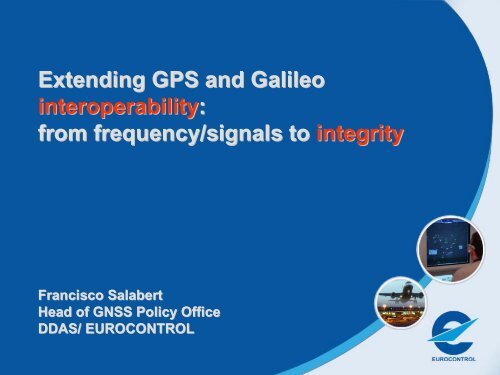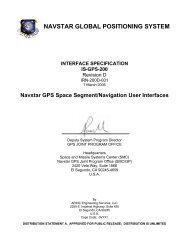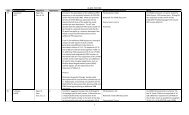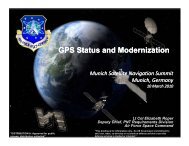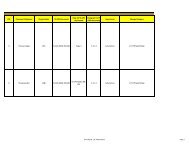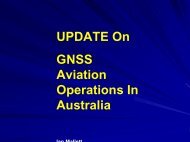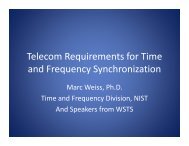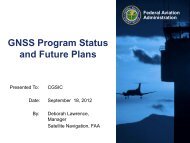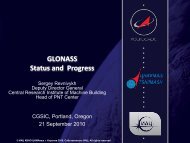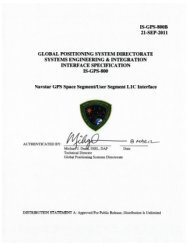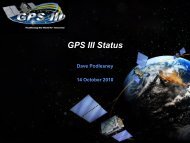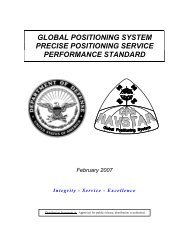View presentation (815 KB PDF) - GPS.gov
View presentation (815 KB PDF) - GPS.gov
View presentation (815 KB PDF) - GPS.gov
- No tags were found...
Create successful ePaper yourself
Turn your PDF publications into a flip-book with our unique Google optimized e-Paper software.
EUROCONTROL role on GNSSLong term involvement on GNSS mattersEUROCONTROL is contributing to the development of GNSSapplications addressing different aspects: Safety Technical Operational Economic Institutional Legal SecurityFocal point in the definition of the needs of aviation regarding GNSSPlaying a major role in the operational validation of GNSSperformance according to aviation requirements.
Overall use of GNSS in aviation applicationsCivil domainSurveillance(ADS-B)NavigationAirportoperationsTimingMilitary domain (based on <strong>GPS</strong> PPS & Galileo PRS)
Use of <strong>GPS</strong> in European aviation todayAround 70 % of flights are made by aircraft equipped with <strong>GPS</strong>/RAIM.<strong>GPS</strong> offers a very efficient and free service nominally…..but current GNSSbased on <strong>GPS</strong> only has some deficiencies impeding its comprehensive use inaviation: single system/operator single frequency low power signals number of satellites lack of sufficient guaranteesThe use of <strong>GPS</strong> is authorized in Europe since 1998 (for some operations andunder certain conditions) based on a Safety assessment, the existence of ICAOStandards and a letter with a political commitment sent from the US <strong>gov</strong>ernmentto ICAO.Safety Case relies upon reversion to conventional means.
Transition to GNSS in European aviationOperational needsMore capacity to cope with increasing traffic demandsImprove safetyReduce environmental impactLess costs In line with :Technical RealisationMore flexible routes (e.g. RNAV)Mode demanding performance ( e.g. Integrity, Accuracy,..).Safety (e.g. Vertical guidance in approaches)Better surveillance capabilities (ADS-B) to reduce separationsImproved low visibility operationsCommon and accurate time referenceICAO global strategySESAR Master PlanInfrastructureTransition to a multiconstelation GNSS
The scene: GNSS developments and aviationWAASCOMPASS :Beidou FOC(5 SVs )GBAS CAT IEGNOSGalileo :End of IOV(4 operational SVs )GBAS CATIIIGalileo :FOC)(30 operational SVsNew RAIMcapabilitiesCOMPASSFOC )GalileoCOMPASS2006 2007 2008 2009 2010 2011 2012 2013 2014 2015 2016 2017 2018 2019 2020<strong>GPS</strong><strong>GPS</strong> :1 st Block IIR -M(2 nd civil signal )<strong>GPS</strong>:24 Block IIR -M + II-F SVs(L2C FOC )<strong>GPS</strong> :30 Block III SVs(<strong>GPS</strong> III FOC )GLONASS<strong>GPS</strong> :1 st Block IIF launch(3 rd civil signal )<strong>GPS</strong>:1 st Block III launch(3 rd generation <strong>GPS</strong> )<strong>GPS</strong> :24 Block II -F + Block III SVs(L5 FOC )GLONASS :18 active satellites(MOC)GLONASS :24 active satellites(FOC)GLONASS :M programme ends(2 nd civil signal )GLONASS :KM programme to starta) Moving schedule and many uncertainties !b) Many potential combinations of Signals, constellations(FOC)and augmentations (SBAS, GBAS, RAIM, INS,…)c) A new GNSS configuration every 2-3 years …whereas aviation equipment has very long lifecycleand very high installation &certification costs1) Share a GNSS baseline2) Extending interoperabilityto integrity3) Define a Multi-constellation receiverarchitecture:Robustness vs Complexity/costsd) Different integrity schemes/concepts not always compatible.
GNSS components and interoperability levelGNSS componentConstellations:<strong>GPS</strong>, Galileo, GLONASS, COMPASS, QZZS,…Interoperability levelStates level agreements (e.g. US- EU agreement)SBAS ( WAAS EGNOS, MSAS)ICAO standardsInteroperability Working GroupGBAS (CAT I and CAT II/III)ICAO standardsOn board augmentations (e.g. RAIM)and receiversStandardisation bodies ( RTCA, EUROCAE,..)
GNSS constellations<strong>GPS</strong>, Galileo, GLONASSand COMPASSGNSS components and integrityABAS(Aircraft BasedAugmentation System)RAIM and Inertial systemsSBAS (Satellite BasedGBAS (Ground Based Augmentation System)Augmentation System)WAAS, EGNOS, MSAS, GAGAN,…
6) There is a risk of having different receivers standards at regional level.Why we need to extend interoperability to integrity ?Initial ideas for early discussion. External consultation need to be establishedamong stakeholders1) Aviation welcomed the agreement between US and Europe. It is focused onfrequencies /signals, time offset and security aspects. Integrity aspects are not covered.2) GNSS integrity is key for aviation safety. Aviation needs interoperability worldwide.3) Integrity will become more complex in a multi frequency multi constellation environment. Differentintegrity mechanisms and concepts exist but are difficult to be combined at user receiver level in anefficient way:SBAS integrity (applied at regional level). Potential extension to GalileoGBAS integrity (applied at local level. Extension to Galileo to support CAT II/III operations)RAIM integrity concepts and new capabilities (Detection of multiple failures, RRAIM, ARAIM,..)Galileo SoL integrity concept<strong>GPS</strong> III integrity concept4) Integrity is one of the drivers for GNSS systems architectures. There is a need to define a costeffective allocation of integrity burden between constellations, augmentations and user receiver.GEAS study is assessing architectures to provide LPV 200 worldwide based on <strong>GPS</strong> (GIC, RRAIMand ARAIM ). Phase I of GEAS study is based on <strong>GPS</strong> only, could consider Galileo in future work.Galileo SoL is being defined to provide LPV 200 worldwide based on Galileo only.Interoperability is not detrimental to independence.5) Lack of an agreed GNSS baseline on integrity could delay transition to GNSS.
How to extend interoperability to integrity ?Initial ideas for early discussion. External consultation need to be establishedamong stakeholdersGoal: Promote and harmonise integrity concepts and mechanisms that can be applied at user levelworldwide.Recommendation. To reinforce international cooperation at different levels:1. US–EU at programme and political level to assess interoperability between <strong>GPS</strong> and Galileo atintegrity level.2. Coordination between <strong>GPS</strong> evolution studies (e.g. GEAS) and European activities.3. Assess the impact of changing/adapting (on-going and future) technical concepts/developments toimprove interoperability.4. IWG (Interoperability Working Group) for SBAS developments5. Share a GNSS baseline and a transition path between FAA and EUROCONTROL. Coordinationbetween GNSS baseline in SESAR and Next Gen5. Support ICAO standardization processes for global interoperability in aviation6. Promote cooperation between RTCA and EUROCAE for receivers standardization
QUESTIONS ?


